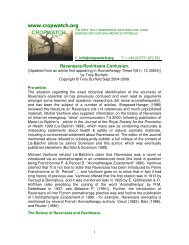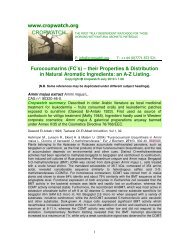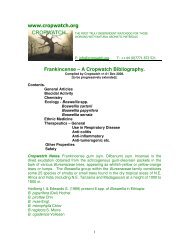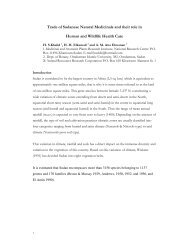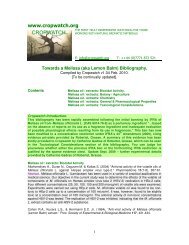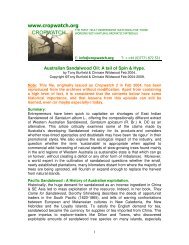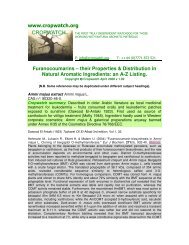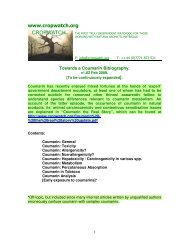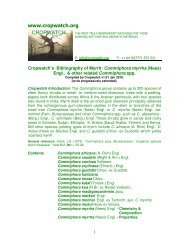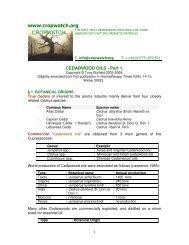Sandalwood Biblio - Cropwatch
Sandalwood Biblio - Cropwatch
Sandalwood Biblio - Cropwatch
You also want an ePaper? Increase the reach of your titles
YUMPU automatically turns print PDFs into web optimized ePapers that Google loves.
treatment of cells with caspase-8 or -9 inhibitor, pan caspase inhibitor or cycloheximide totally<br />
blocked alpha-santalol-caused caspase-3 activity and cleavage, but only partially reversed<br />
apoptotic cell death. This suggests involvement of both caspase-dependent and -independent<br />
pathways, at least under caspase inhibiting conditions, in alpha-santalol-caused apoptosis.<br />
Together, this study for the first time identifies the apoptotic effect of alpha-santalol, and defines<br />
the mechanism of apoptotic cascade activated by this agent in A431 cells, which might be<br />
contributing to its overall cancer preventive efficacy in mouse skin cancer models.<br />
Kim T.H., Ho H., Takayasu T., Tokuda H., Machiguchi M. & T. (2006) "New antitumor<br />
sesquiterpenoids from Santalum album of Indian origin." Tetrahedron 62 (29), 6981-6989.<br />
Abstract. Three new campherenane-type (1, 4, 7) and three new santalane-type (9, 11, 12)<br />
sesquiterpenoids, and two aromatic glycosides (21, 22) together with 12 known metabolites<br />
including β-santalols (14, 18), (E)-,β-santalals (15, 19), β-santaldiols (16, 20), -santalenoic acid<br />
(17), and vanillic acid 4-O-neohesperidoside were isolated from Santalum album chips of Indian<br />
origin. The structures of the new compounds, including absolute configurations, were elucidated<br />
by 1D- and 2D-NMR spectroscopic and chemical methods. The antitumor promoting activity of<br />
these isolates along with several neolignans previously isolated from the same source was<br />
evaluated for both in vitro Epstein–Barr virus early antigen (EBV-EA) activation and in vivo twostage<br />
carcinogenesis assays. Among them, compound 1 exhibited a potent inhibitory effect on<br />
EBV-EA activation, and also strongly suppressed two-stage carcinogenesis on mouse skin.<br />
Graphical abstract.<br />
Kim T.K., Ito H., Hayashi K., Hasegawa T., Machiguchi T. & Yoshida T. (2005) "Aromatic<br />
Constituents from the Heartwood of Santalum album L." Chem. Phar. Bull. 53(6), 641-644.<br />
Abstract. A phytochemical investigation of the polar constituents in the heartwood of Indian<br />
Santalum album L. resulted in the isolation of three new neolignans (1—3) and a new aromatic<br />
ester (4), along with 14 known components. The structures of the new compounds (1—4) were<br />
established using spectroscopic methods.<br />
Matsuo Y. & Mimaki Y. (2010) "Lignans from Santalum album and their cytotoxic activities."<br />
Chem Pharm Bull 58(4):587-90. Abstract. A new neolignan, (7R,8R)-5-O-demethylbilagrewin (1),<br />
together with four known lignans (2-5), were isolated from the heartwood of Santalum album<br />
(Santalaceae). The structure of 1 was determined by analysis of extensive spectroscopic data.<br />
The isolated compounds and derivatives were evaluated for their cytotoxic activities against HL-<br />
60 human promyelocytic leukemia cells and A549 human lung adenocarcinoma cells.<br />
Compounds 1 and 2 exhibited cytotoxicity against HL-60 cells with IC(50) values of 1.5+/-0.02<br />
and 4.3+/-0.13 microM, and against A549 cells with IC(50) values of 13.6+/-0.32 and 19.9+/-1.27<br />
microM, respectively. The aldehyde group of 1 and 2 was revealed to be a structural requirement<br />
for the appearance of cytotoxicity in this type of lignans. These tumor cell deaths were shown to<br />
be mediated through induction of apoptosis.<br />
Palep S. & Lebwohl M. (2007) "Inhibitory effects of alpha- and beta-santalol on UVB-induced<br />
mouse skin carcinogenesis." Journal of the American Academy of Dermatology 56(2) Suppl. 2,<br />
pAB36.<br />
Chemistry of E.I. <strong>Sandalwood</strong>.<br />
Anonis D.P. (1998) “<strong>Sandalwood</strong> & sandalwood compounds” Perf. & Flav. 23(5), 19-24.<br />
Bajgrowicz J.A. & Frater G. (2000) "Chiral recognition of sandalwood odourants." Enantiomer<br />
5(3-4), 225-234. Abstract: Looking for more efficient sandalwood oil smelling compounds, new<br />
32





